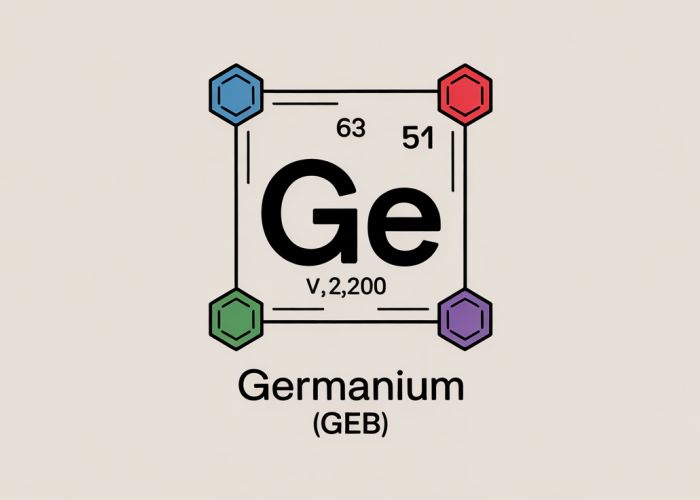Germanium, a pivotal element in semiconductor technology, exhibits unique chemical properties. Its behavior is significantly influenced by its valency of Ge, a characteristic that dictates its bonding configurations. Exploring the Periodic Table reveals that Germanium (Ge) resides in Group 14, indicating a typical valency of four, allowing it to form stable compounds with elements such as Oxygen. Understanding this valency is crucial for Materials Science engineers designing advanced electronic devices, while researchers at institutions like the Max Planck Institute have furthered our understanding of Germanium’s diverse applications.

Understanding Germanium’s Bonding Behavior: A Deep Dive into the Valency of Ge
This explanation will break down the valency of Germanium (Ge), exploring what it means, how it affects its chemical behavior, and why it’s important.
What is Valency?
Before diving into the specifics of Germanium, let’s define valency. Valency represents the combining capacity of an element. In simpler terms, it’s the number of chemical bonds an atom of that element can typically form with other atoms. This capacity is primarily dictated by the number of electrons in the outermost shell of an atom, known as valence electrons.
- Valence electrons determine the element’s ability to interact and form bonds with other elements.
- The goal for atoms is often to achieve a stable electron configuration, mimicking noble gases (like Neon or Argon) which have a full outer shell.
- Elements achieve this stability by gaining, losing, or sharing electrons through chemical bonds.
Germanium’s Electronic Configuration and Valency
Germanium (Ge) resides in Group 14 (also known as Group IVA) of the periodic table. This placement is crucial to understanding its valency.
- Germanium has an atomic number of 32.
- Its electronic configuration is 1s² 2s² 2p⁶ 3s² 3p⁶ 3d¹⁰ 4s² 4p².
- Therefore, Germanium has 4 electrons in its outermost shell (4s² 4p²). These are its valence electrons.
Primary Valency of Germanium: +4
The most common and stable valency exhibited by Germanium is +4. This stems directly from having 4 valence electrons. To achieve a stable octet (8 electrons in the outer shell), Germanium tends to share these 4 electrons via covalent bonds.
- When forming compounds, Germanium often shares its four valence electrons with four other atoms.
- This results in the formation of four covalent bonds.
- Examples include Germanium Dioxide (GeO₂) and Germanium Tetrachloride (GeCl₄). In both, Germanium forms four bonds.
Other Possible Valencies: +2
Although +4 is the predominant valency, Germanium can also exhibit a +2 valency under specific conditions. This occurs when only two of the four valence electrons participate in bonding.
- This is less stable than the +4 valency.
- Compounds with Ge in a +2 oxidation state are often more reactive.
- An example is Germanium Monoxide (GeO), which is less stable compared to GeO₂.
Factors Influencing Germanium’s Valency
Several factors can influence whether Germanium adopts a +4 or +2 valency in a particular compound:
- Electronegativity of the Bonding Atoms: The electronegativity difference between Germanium and the atoms it’s bonding with plays a role. If the electronegativity difference is high, ionic character may be favored, potentially influencing the valency.
- Reaction Conditions: Temperature, pressure, and the presence of other reactants can shift the equilibrium and affect the favored oxidation state of Germanium.
- Steric Hindrance: The size and shape of the surrounding atoms (ligands) can influence the accessibility of the valence electrons, affecting the formed valency.
Examples of Germanium Compounds and their Valency
This table illustrates how Germanium’s valency manifests in common compounds:
| Compound | Germanium’s Valency | Explanation |
|---|---|---|
| Germanium Dioxide (GeO₂) | +4 | Each Oxygen atom (O) forms two bonds, totaling four bonds for Ge. |
| Germanium Monoxide (GeO) | +2 | Each Oxygen atom (O) forms two bonds, totaling two bonds for Ge. |
| Germanium Tetrachloride (GeCl₄) | +4 | Each Chlorine atom (Cl) forms one bond, totaling four bonds for Ge. |
| Germanium Hydride (GeH₄) | +4 | Each Hydrogen atom (H) forms one bond, totaling four bonds for Ge. |
Importance of Understanding Germanium’s Valency
Understanding the valency of Germanium is vital for:
- Predicting the formation of Germanium compounds: Knowing the possible valencies allows chemists to predict how Germanium will react and combine with other elements.
- Designing new materials: Germanium’s unique electronic properties, related to its valency, are crucial in semiconductor technology. The valency influences the material’s conductivity.
- Understanding the chemical behavior of Germanium: Knowledge of its valency is key to comprehending the behavior of Germanium in various chemical reactions and environmental conditions.
FAQs: Understanding Germanium’s Valency
Here are some common questions about the valency of germanium and its implications.
What is the valency of germanium (Ge)?
Germanium (Ge) primarily exhibits a valency of 4. This means a germanium atom typically forms four covalent bonds with other atoms to achieve a stable electron configuration.
Why does germanium usually have a valency of 4?
Germanium has four valence electrons in its outermost shell. To achieve a stable octet (8 electrons), it shares these four electrons with other atoms, resulting in a valency of 4. This makes it suitable for forming tetrahedral structures.
Can germanium have other valencies besides 4?
While the valency of Ge is most commonly 4, it can exhibit other valencies in certain compounds and under specific conditions. Germanium(II) compounds exist, but they are less stable than germanium(IV) compounds. The +4 oxidation state and thus valency is the most dominant.
How does the valency of Ge affect its use in semiconductors?
The valency of germanium is crucial to its semiconductor properties. Its ability to form four bonds allows it to create crystal lattices with other elements, like silicon, enabling the doping process necessary for creating transistors and other electronic components. Understanding the valency of Ge is key to manipulating its electrical conductivity.
So, now you’ve got a better handle on the valency of Ge! Hopefully, this has helped you unlock some of the mystery behind this cool element. Thanks for checking it out!